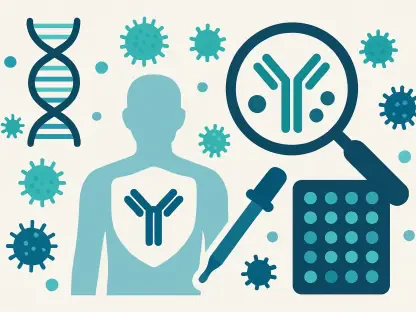Multiple myeloma, a challenging blood cancer, affects thousands of individuals annually, often progressing from a precursor condition known as high-risk smoldering multiple myeloma (HR-SMM). With around 50% of HR-SMM cases advancing to active disease within just a couple of years, the stakes are incredibly high for patients facing this silent threat. This roundup article dives into the groundbreaking shift toward early intervention, spotlighting the recent FDA approval of DARZALEX FASPRO as a pioneering treatment for HR-SMM. By gathering insights from various medical perspectives, industry analyses, and patient advocacy groups, this discussion aims to explore whether acting early can truly alter the trajectory of multiple myeloma and what this means for those at risk.
Perspectives on Early Intervention in HR-SMM
The Breakthrough of DARZALEX FASPRO
Insights from clinical research communities highlight the monumental impact of DARZALEX FASPRO, marking it as the first approved therapy specifically for HR-SMM. Data from the phase 3 AQUILA trial, which demonstrated significant improvements in progression-free survival, has been widely praised for showing a reduced risk of advancement to active multiple myeloma. Many in the oncology field view this as a critical step in redefining how precursor conditions are managed, emphasizing the therapy’s potential to delay debilitating symptoms.
Contrasting opinions emerge regarding the balance of benefits versus risks with early treatment. Some medical professionals express caution about potential side effects and the possibility of over-treatment in patients who might not progress rapidly. However, a growing consensus acknowledges that the manageable safety profile of this therapy, consistent with prior studies, tilts the scale toward proactive intervention for high-risk cases.
A third angle from patient advocacy networks focuses on accessibility and education surrounding this new option. There’s a shared concern that while the treatment offers hope, ensuring patients and caregivers understand its implications and availability remains a hurdle. These groups advocate for broader discussions on integrating such therapies into standard care protocols.
Shifting from Passive Monitoring to Active Care
The traditional “watch and wait” approach for HR-SMM has long been debated, and many healthcare providers now argue that the approval of DARZALEX FASPRO signals a necessary pivot to active management. Reports from clinical forums suggest that this shift could significantly delay the onset of aggressive treatments, potentially improving long-term outcomes for patients. This perspective sees early action as a way to preserve quality of life before severe symptoms manifest.
Patient outcome analyses shared by oncology support organizations paint a vivid picture of the real-world impact. Cases where early intervention delayed disease progression have been cited as evidence of a tangible benefit, reducing the immediate burden of more invasive therapies. Such stories underscore the value of moving beyond mere observation to a more engaged strategy.
On the flip side, some healthcare policy experts warn that the risks of inaction may be overstated in certain contexts. They argue that not all HR-SMM cases warrant immediate treatment, and a blanket push for early intervention could strain resources or lead to unnecessary medicalization. This viewpoint calls for personalized assessments to ensure that intervention aligns with individual patient needs and disease risks.
Broader Trends in Targeting Precursor Conditions
Across the oncology landscape, there’s a noticeable movement toward addressing precursor conditions before they escalate, with HR-SMM treatment often cited as a leading example. Global health research communities note that early intervention aligns with a proactive ethos gaining traction in cancer care, aiming to alter disease courses at the earliest possible stage. This trend is seen as a potential model for other malignancies with identifiable precursors.
Differing views on adoption come from international healthcare systems, where variations in policy and resource allocation influence how quickly such therapies are integrated. In regions with robust infrastructure, there’s optimism about rapid implementation, while others express concern over disparities in access. These perspectives highlight a need for global collaboration to standardize early intervention protocols.
A more critical stance from some industry analysts questions whether this trend might overextend into areas where evidence is less conclusive. There’s a worry that applying early treatment universally across precursor conditions could lead to resource depletion or interventions that offer minimal benefit. This cautionary note urges a balanced approach, prioritizing robust data before widespread application.
Emotional and Practical Impact on Patients
From the patient advocacy sphere, there’s a strong emphasis on the psychological relief that comes with having an early treatment option like DARZALEX FASPRO. Knowing there’s a way to act before symptoms worsen has been described as a source of renewed hope, reducing the anxiety of waiting for disease progression. This human dimension adds depth to the clinical discussion, focusing on mental well-being alongside physical health.
Comparisons to other early-stage cancer therapies reveal a shared optimism among researchers about building on current successes. Some speculate that future innovations could refine these approaches, potentially offering even more tailored solutions for HR-SMM. This forward-looking view encourages ongoing investment in research to enhance early intervention strategies.
A unique perspective from counseling groups within healthcare suggests that this therapy reshapes patient-doctor dialogues. Conversations about risk and proactive care are becoming more collaborative, empowering patients to engage actively in decision-making. This shift is seen as a cultural change in how precursor conditions are perceived and managed within medical settings.
Key Takeaways from Diverse Voices
Synthesizing opinions from clinical, policy, and patient advocacy domains, the approval of DARZALEX FASPRO stands out as a transformative milestone in HR-SMM care. The consensus leans toward its proven efficacy and safety as a compelling reason to adopt early intervention, though debates persist on the scope and timing of such treatments. Many agree that this development challenges the status quo of passive monitoring, pushing for a more dynamic response to precursor conditions.
Practical insights for patients and caregivers include initiating discussions about early intervention as soon as a diagnosis of HR-SMM is confirmed. Healthcare providers are encouraged to stay updated on clinical trial outcomes and emerging therapies to guide informed choices. Navigating treatment decisions also involves weighing individual risk factors against the benefits of acting early, ensuring a tailored approach.
A notable divergence in thought centers on resource allocation and the risk of over-treatment, with some advocating for stricter criteria on who qualifies for early therapy. Despite these concerns, the overarching narrative remains one of progress, with a collective push to redefine standards of care in multiple myeloma through proactive measures.
Reflecting on a Paradigm Shift
Looking back, the discourse around early intervention in HR-SMM revealed a profound shift in how precursor conditions are approached within oncology. The introduction of DARZALEX FASPRO as a viable treatment option marked a turning point, sparking vital conversations across medical and patient communities. These discussions underscored a shared commitment to altering disease trajectories before severe impacts took hold.
Moving forward, patients and healthcare providers should prioritize access to educational resources to better understand early treatment options. Exploring clinical trials and advocating for expanded coverage of innovative therapies could bridge existing gaps in care. Additionally, fostering global partnerships to address disparities in implementation remains a critical next step to ensure equitable benefits from such advancements.









